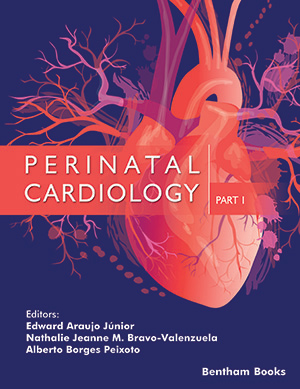Abstract
The fetal right heart malformations are a heterogeneous group of anomalies that basically involve the tricuspid and pulmonary valves. Ebstein´s anomaly usually consists of the existence of a downward displacement of the insertion of the septal and posterior leaflets of the tricuspid valve. Tricuspid dysplasia is an abnormality of the chordae tendinae and/or the leaflets, which are thickened, of a normally inserted tricuspid valve. Both conditions are characterized by an incomplete closure of the valve in systole, causing tricuspid regurgitation that may cause cardiomegaly, heart failure and hydrops. Chromosomal defects are rare and the mortality for prenatally detected forms is high, with survival rates at 5 years less than 25%. In tricuspid atresia there is a replacement of the valve by a fibromuscular tissue and is almost always associated with a ventricular septal defect. The right ventricle is invariably hypoplastic, and in up to 25% of cases there is ventriculo-arterial discordance. Chromosomal abnormalities are rare, and the outcome is usually good, with survival rates at 20 years of 61-75%. In mild to moderate forms of pulmonary stenosis, the pulmonary valve appears thickened and/or narrowed, and is visible continuously throughout the cardiac cycle. The fourchamber view is usually normal. On color Doppler, there is high-velocity turbulent flow across the pulmonary valve. The outcome is good in most cases. In severe forms of pulmonary stenosis or pulmonary atresia with intact ventricular septum there is an almost complete obstruction of the right ventricle outflow tract due to severe dysplasia or complete absence of the pulmonary valve, respectively. This can be assessed both in B-mode and with color Doppler. The only route for blood supply to the lungs is the ductus arteriosus. Depending on the tricuspid valve, the right ventricle can be severely small or normal sized, which has a paramount importance on the final outcome. Acquired forms of premature closure of the ductus arteriosus can be idiopathic or secondary to the administration to the mother of some medical treatments. It often appears abruptly, in the third trimester of pregnancy. The Doppler study shows an acceleration of the transductal flow, with a peak systolic velocity greater than 140 cm/s, a diastolic peak greater than 35 cm/s, and a pulsatility index lower than 1.9 m/s. When the closure is complete, there is an asymmetric cardiomegaly because of dilatation of the right chambers, right ventricle hypertrophy and dilatation of the pulmonary artery and branches, while the duct is narrowed.
Keywords: Ebstein’s anomaly, Premature closure of the ductus arteriosus, Pulmonary atresia with intact ventricular septum, Pulmonary stenosis, Tricuspid atresia, Tricuspid dysplasia.






















